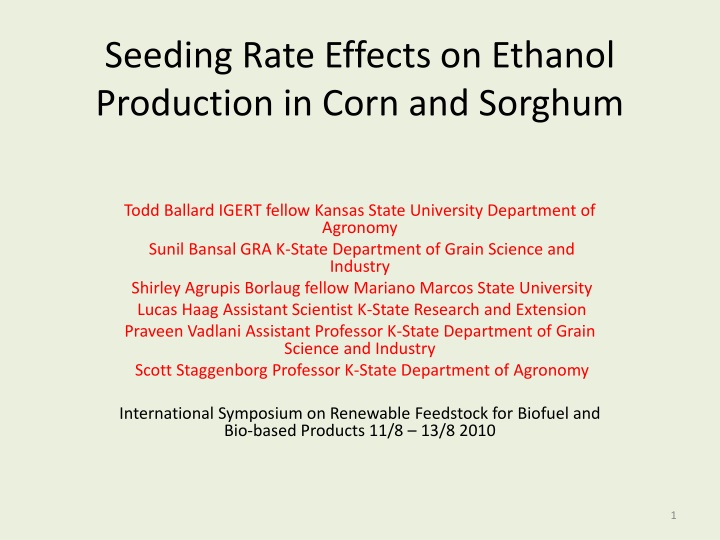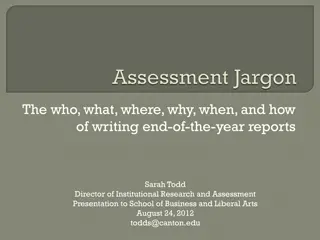
Seeding Rate Effects on Ethanol Production in Corn and Sorghum Study
This study conducted at Kansas State University explores the impact of seeding rates on ethanol production in corn and sorghum crops. Researchers investigated the relationship between plant population densities and ethanol yield per hectare to optimize production while minimizing the effects on food supply. Various models were utilized to assess population relationships, and the study was carried out in different locations with varying rainfall levels.
Download Presentation

Please find below an Image/Link to download the presentation.
The content on the website is provided AS IS for your information and personal use only. It may not be sold, licensed, or shared on other websites without obtaining consent from the author. If you encounter any issues during the download, it is possible that the publisher has removed the file from their server.
You are allowed to download the files provided on this website for personal or commercial use, subject to the condition that they are used lawfully. All files are the property of their respective owners.
The content on the website is provided AS IS for your information and personal use only. It may not be sold, licensed, or shared on other websites without obtaining consent from the author.
E N D
Presentation Transcript
Seeding Rate Effects on Ethanol Production in Corn and Sorghum Todd Ballard IGERT fellow Kansas State University Department of Agronomy Sunil Bansal GRA K-State Department of Grain Science and Industry Shirley Agrupis Borlaug fellow Mariano Marcos State University Lucas Haag Assistant Scientist K-State Research and Extension Praveen Vadlani Assistant Professor K-State Department of Grain Science and Industry Scott Staggenborg Professor K-State Department of Agronomy International Symposium on Renewable Feedstock for Biofuel and Bio-based Products 11/8 13/8 2010 1
Biomass and Bioethanol Biomass is any organic matter, Including trees, plants, plant fiber, and animal wastes. Renewable energy source Ethanol produced by hydrolysis of biomass to sugars and their fermentation is called as bioethanol Benefits include decoupling of food and bioenergy, reduce CO2 emissions and ensurance of stable supply of energy (Larsen et al., 2008) 2
Process Flowchart for Ethanol from Biomass Enzymatic hydrolysis Biomass feedstock Pretreatment Fermentation Ethanol Lignin and residue Lignin Chemicals, feed or combustion for generation of energy 3
Goals To produce ethanol from corn (Zea mays L.) stover and sweet sorghum (Sorghum bicolor L. cultivar sweet) begasse To find a relationship between plant population densities and ethanol yield/ha To minimize the impact of ethanol production of food supply from both crops 4
Background Population Relationships Used Duncan grain yield model (Duncan, W.G. 1958) Shinozaki and Kira biomass model (Shinozaki, K. and T. Kira 1956) Russell biomass model (Russell, M.W. 1979 and Ballard 2008) 5
Locations Manhattan, KS 39.19 0 N 89 cm rain/yr Tribune, KS 38.28 0 N 44 cm rain/yr Garden City, KS 37.99 0 N 48 cm rain/yr 7
Seeding Rates for Corn Manhattan No competition: 2,900/ha 37,000/ha 64,000/ha 103,000/ha 140,000/ha Tribune No competition 29,600/ha 44,500 59,200 8
Corn Grain Yield 2009 Manhattan Corn Grain Yield 2009 Tribune Corn Grain Yield 700 600 g r a i n / p l a n 600 g r a i n / p l a n y = 373.44e-3E-05x R = 0.7283 y = 463.98e-1E-05x R = 0.9373 500 500 400 400 300 300 200 200 100 100 0 0 t( g) 0 20000 40000 population*ha-1 60000 80000 100000 0 50000 100000 150000 200000 t( g) population*ha-1 9
Total Corn Biomass Total Biomass Tribune Corn Manhattan Total Aboveground Biomass 25000 y = 0.2308x + 3187.6 R = 0.763 35000 20000 30000 k g / h a 15000 k g / h a 25000 20000 10000 15000 10000 5000 5000 0 0 0.00 20000.00 40000.00 60000.00 80000.00 100000.00 0 50000 100000 plants*ha-1 150000 200000 plants*ha-1 10
Corn Stover Yield Manhattan stover/ha Tribune Stover/ha 18000 20000 y = 0.1812x + 579.01 R = 0.8304 18000 16000 16000 14000 k g / h a 14000 k g / h a 12000 12000 10000 10000 8000 8000 6000 6000 4000 4000 2000 2000 0 0 0 20000 40000 60000 80000 100000 0.00 50.00 100.00 150.00 200.00 Plants/ha thousand plants/ha 11
Seeding Rates for Sorghum Manhattan 74,000/ha 148,000/ha 222,000/ha Garden City 37,000/ha 74,000/ha 111,000/ha 13
Begasse Yield Garden City Begasse Manhattan Begasse Yield 16000 70000 14000 60000 12000 k g / h a k g / h a 50000 10000 40000 8000 30000 6000 20000 4000 10000 2000 0 0 0 100000200000300000400000500000600000700000 plants*ha-1 0 100000 200000 300000 plants*ha-1 400000 500000 600000 14
Ethanol Process Acid hydrolysis 2% H2SO4 1210 C for 30 minutes Wash to remove acid Add pH 5.0 citric acid as a pH buffer Add cellulase (22074) and glucosidase (50010) from Novozyme 72 hr enzyme hydrolysis Fermentation Yeast extract Ammonium Sulfate Yeast 15 hr 15
Ethanol Results Manhattan Bagasse produced: 0.05 g ethanol/g biomass (0.02 0.08) Garden City Bagasse produced: 0.08 g ethanol/g biomass (0.03 -0.16) Corn Stover ethanol yield varied by population 17
Corn Population Effect Plant Density g ethanol/g biomass 138,000 0.039 105,500 0.045 85,300 0.047 47,400 0.045 2,900 0.042 18
Conclusions A model is being developed to explain the relationship between sorghum population density and the total cellulosic ethanol/ha Corn cellulosic ethanol/g appears to be steady. Further studies will be completed to look for significant differences. Combining the biomass/ha and ethanol/g reveals the total ethanol/ha Minimal changes in grain yield/ha over a 12,000 plant/ha domain for corn This allows for adjusting the seeding rate within this domain to maximize cellulosic ethanol production without effecting grain yield 19






















